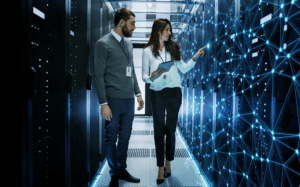
It is not so easy to be both sustainable and profitable, many would argue these are conflicting objectives. Or are they? The good news is that digital technologies make it possible for companies to not only monitor and reduce the amount of energy and raw materials used in producing their products but to also ensure they’re resourced sustainably. All without negatively impacting their financial performance.
Digital technologies can help companies ensure their operations and supply chains are both sustainable and profitable by:
- Tracking and evaluating the carbon footprint of energy sources, raw materials and parts across all production lines and equipment in the plant and supply chain (Efficient Production)
- Taking sustainability into consideration during the various stages of a product’s life cycle (Green Product)
- Making a public social commitment to environmental sustainability by setting science-based targets (Social Commitment)
Environmental Sustainability helps plants improve operational efficiency, gain more business, attract new talent, and investment, all while addressing present and future challenges to our planet and society.
As David Attenborough says in ‘A Life On Our Planet: My Witness Statement And A Vision For The Future’:
“a type of growth that has no negative impact on the environment. Green growth may come from making products more energy-efficient, or from turning dirty, impactful activities into clean, low or zero-impact activities, or from driving growth in the digital world, which, when powered by renewables, could be described as a low-impact sector”.
Efficient Production
All efforts to improve production efficiency are strongly linked to improvements in sustainability. With the help of smart connected equipment, digitization and analytics, companies can understand the carbon impact of energy sources, raw materials and parts and make sure all of these are used in the most efficient ways across plant’s production lines and equipment.
A successful sustainability program should address the following three aspects:
- People: the social equity bottom line which is a measure of fair and beneficial business practices and is linked to equity, fair trade, employee welfare, safety, etc.
- Planet: the environmental bottom line which addresses the business impact on the environment and is linked to resource consumption, waste management, etc.
- Profit: the economic bottom line which measures the economic value created by the business and is linked to revenue, profits, etc.
As well as improving the bottom line, this helps drive a positive perception of a company’s reputation and brand in the marketplace leading to increased sales, better talent acquisition/ retention and overall long-term business resiliency.
Green Product
Today many of us want to minimize our individual impact on the environment. We want to know the products we buy have been designed and manufactured in an environmentally responsible way, and that they can be responsibly disposed of or recycled at the end of their lives.
In other words, the product’s manufacturer’s design criteria should be based on ‘5R’ principles or how the final product could be Repaired, Reused, Refurbished, Remanufactured or Recycled. This is a critical part of achieving carbon neutrality for the plant, its supply-chain and the product itself.
Social Commitment Customer and investor demands for sustainable operations continue to rise and before long they’ll affect the capital and sales revenues available to industrial businesses. Companies must take action now to ensure the very survival of their businesses. This means making public social commitments to environmental sustainability by setting science-based targets to reduce emissions and slow climate change, achieving net carbon neutrality by offsetting the carbon footprint of both their operations and their supply chain.
Digital technologies are available today to make sustainability a reality:
Schneider Electric’s EcoStruxure Plant Advisor is the world’s first open ecosystem dedicated to solving real-world sustainability and efficiency challenges.
“The need for agility cannot be over emphasized for industrial operations,” said Craig Resnick, Vice President, ARC Advisory Group. “The EcoStruxure™ Plant Advisor suite provides industrial operations with the real-time visibility needed to understand the intricacies of operations that enables this agility. This information empowers a business to pivot and an operation to maximize production efficiency while reducing energy consumption, waste, and labor costs.”
At Schneider Electric, we see electrification and digitization as inseparable and critical parts of the fight against climate change. Consistently recognized globally in sustainability, just recently by Microsoft (July 2021) -Schneider Electric Recognized as 2021 Microsoft Sustainability Changemaker Partner of the Year Award Winner and by Corporate Knights (January 2021) – Schneider Electric ranked world’s most sustainable corporation.
Digital technologies which interact securely across domains can help companies track and achieve their sustainability goals. It’s also important for companies to work together to share best practices and make the most of expertise from leaders in the field.



